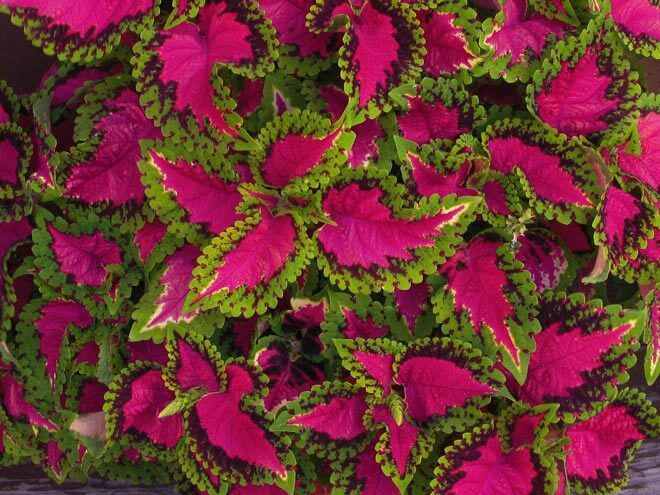Coleus is a plant of tropical origin that has always been used to decorate the interior of our homes . The reasons are obvious; there is more to see the tremendous beauty of its variegated leaves. Grown mainly indoors due to its low tolerance to cold, it is also possible outdoors where the weather allows it.
It is very possible that you already know him; this is the coleus (Solenostemon sp), also known as cretonne . Semi-bushy, it can reach up to a meter in height, although planted in a pot it does not usually exceed fifty centimeters. Its tropical origin (Southeast Asia) gives us many clues about its needs, which we will see in detail later.
Coleus is one of the most common plants in homes around the world. The reason for such popularity is not a secret: the leaves seem carefully painted and spruced up with their bright colors (they can be yellow, purple, brown, green or scarlet), arranged in pairs, facing each other, forming a set very striking.
Here it is again so you can see some of the varieties. This is just an example; there are many other colors.
It seems that nurserymen have had time to experiment by selecting and hybridizing to achieve new fantasies.
It is also an easy species to reproduce, both by seed and by cutting. That is why the cost of a coleus is very affordable; it is often used even outdoors as a seasonal plant .
Indoor or outdoor?
However, the coleus is above all an indoor plant : the main limiting factor in gardens or terraces is the cold. If winter is mild in your city, you can also enjoy it outside your home. But beware, whenever you place it in the shade… direct sun is fatal: it burns the leaves.
What temperatures are we talking about? It is comfortable around 20ºC and begins to feel cold below 10ºC. However, if it is well acclimatized, it can withstand outside temperatures close to 0ºC.
You know, if other conditions exist in your area, it is better that you do not consider growing it outside the house or at least bring it in when the cold arrives.
Substrate and plantation
Coleus are not fussy about soil ; with any standard substrate they will feel comfortable. Of course, they prefer it somewhat loose to facilitate drainage, and if it has a slightly acidic pH, the better.The coleus stands out among the others for its fantasy leaves
According to this, a special mixture can be made à la carte: a universal substrate base mixed with peat or heather soil plus a pinch of sand can be the delight of our cretonne.
When planting it in the pot , make sure that it also has sufficient drainage . The holes in the base must evacuate the outflow of water without obstacles, otherwise problems at the root level will become apparent.
Location of the coleus
For coleus, the light situation is a very important factor. Indoors it needs a lot of light , but not direct, to stay healthy and preserve its colors. If the leaves do not receive enough light, they will look dull and may even fall. Place it near a window whenever possible.
Other circumstances that can cause leaves to fall are drafts and sudden changes in temperature; Avoid the influence of air conditioning.
Never spray the leaves of the coleus with water, it could cause problems
Also be careful with the heating in winter; the coleus accuses the lack of environmental humidity. To alleviate it, do not spray the leaves, it is not a good idea. Put a container or saucer with water and gravel under the pot. Remember to lodge the pebbles to isolate the roots from the water.
Irrigation and fertilizer
Irrigation is the most delicate point in the care of the coleus. In summer , moisturize regularly but in moderation each time. Don’t let the soil dry out completely (check constantly); but do not allow it to remain waterlogged either. The substrate that we have talked about before will make your job easier.
In winter let the plant rest: lower the frequency of watering to avoid rotting the roots.
It is important during the growth period to consider its fertilization, essential if your plant is in a pot. In this case, the ideal is to add a liquid fertilizer to the irrigation water; every 2 or 3 weeks will suffice.
Pruning
Of course, good lighting, together with the correct irrigation and fertilization of the plant, make things much easier. But the last secret to achieve a compact and lush growth is the pinching of the coleus .
Prune the tips if you see it too spindly, this way you will limit the growth in height allowing it to gain volume.
The leftover stems can be used to reproduce your cretonne; its cuttings are easy to root. Look at the link where I explain the cutting technique .
Remove the flowers : in autumn or winter the flower spikes will emerge. You should always remove them -fundamental- as soon as they appear. Lacking the slightest grace, they not only do not decorate but also reduce the vigor of the plant.
Coleus are plants with few pest problems . They can be attacked perhaps by aphids or spider mites in environments with low humidity, something that can be easily solved with organic products (see the links).
But the biggest disappointments are due to errors in their care . Insufficient or excessive watering, lack of light or burned leaves, sudden changes in temperature or drafts can make your coleus go, from one day to the next, from being radiant to looking sad or without leaves.
They are very pretty plants, yes, but delicate, that cannot be denied.
And you already knew the coleus? Surely yes. Tell me how it goes with this plant.